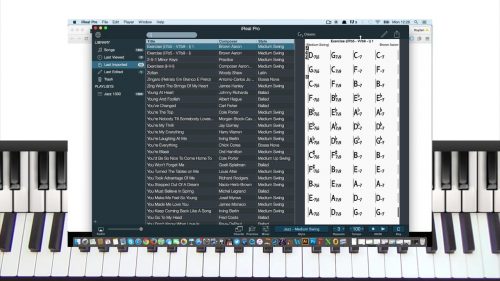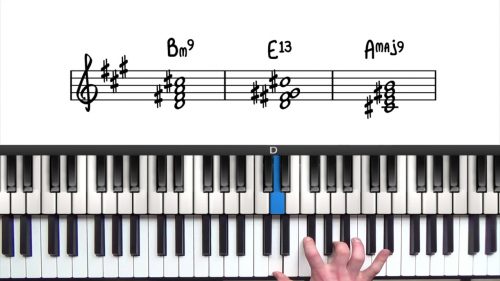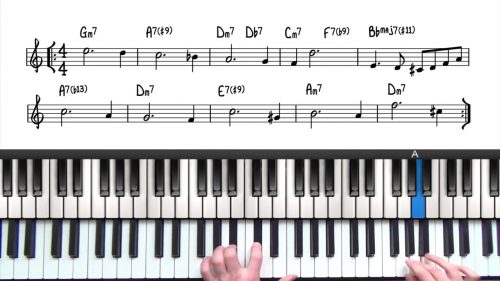Quartal Comping Voicings For Jazz Piano
Welcome to this lesson on quartal 251 voicings. In previous lessons in the PianoGroove course, we have covered upper structure voicings, and also voicings built from 4th intervals such as the So What Voicing.
In this lesson we will combine this information to create some quartal upper structure voicings that are well suited to a comping setting.
We’re going to start by outline a few useful formulas that you can apply to 251s in any key to get some great sounding two-handed comping voicings.
There’s 3 general rules to follow when playing these 251 voicings:
Rule 1 is that for major and minor chords, the left-hand plays a stack of fourths and the right-hand plays a major triad.
Rule 2 is that for dominant chords, the left-hand plays a tritone interval, and again the right-hand plays a major triad.
Rule 3 is that for -7b5 chords, the left hand will play the root and the b5 of the chord, and the right-hand plays a major triad.
So your right hand will always be playing a major triad for all chords in the 251 progression – that applies to both major and minor 251s.
Similarities Between Quartal Voicings
If we take a closer look at these voicings, we can see that they share a lot of similarities with the 251 in Eb Major. We used the same stack of 4ths for the ii chord in both keys. This is because 4ths are tonally ambiguous and can function as many different chords or keys.
This is what makes them so well suited to comping, because it gives the soloist a lot of harmonic and melodic freedom.
Let’s finish by playing through the form of TWNBAY, and we will now add these quartal UST voicings in the place of the major 251s
Practice Tips
-
In the same way that rootless left-hand voicings sound best around middle C, these quartal stacks sound the best right in the center of the piano.
-
Depending on the key, some of these voicing sets will work better than others.
-
In the key of C, I personally prefer the first 2 sets, as they are more in the sweet spot of the piano which is right around middle C.
- The trick to learning these voicings sets is to memorise the formulas.





Please publish the transcriptions in all of these lessons. Thanks
Hi Michele,
I have replied in the forum here with some graphics for you: https://community.pianogroove.com/t/lesson-transcriptions/2447/5
Cheers!
Hayden
Hi Hayden, this link doesn’t work any more.
Saludos Manfred
Hi Manfred,
Thanks for letting me know about this. I have fixed the link.
https://community.pianogroove.com/t/lesson-transcriptions/2447/5
Let me know if I can help further.
Cheers, Hayden
I’m struggling with quartile harmony because It’s so new to me. I’m on my fourth time through this lesson and haven’t attempted the minors yet!
How is it that fourths sound just fine in harmony yet they are often regarded as “avoid” notes in improvisation?
Hi George 👋🏻
Good question.
Firstly, quartal harmony is challenging to begin with so do be patient with it. When we start to learn jazz piano we first cover triads and 7th chords which are built from 3rd intervals so we are conditioned into visualising chord shapes with 3rds.
As we demonstrate in this lesson we can also use 4ths but the interval shapes are harder to visualise, particularly when there is a mixture of black and white notes. My first bit of advice is to be patient with it. Also we have 2 lessons on the So What Voicing which is a great quartal voicing to start with, here are those 2 lessons for your reference:
So What Chords Intro: http://www.pianogroove.com/jazz-piano-lessons/so-what-chord-voicing/ The Major So What Variation: http://www.pianogroove.com/jazz-piano-lessons/major-so-what-variation/
To answer your question on harmony vs melody:
Voicings built from 4ths are harmonically ambiguous. This makes them well suited to comping because it gives the improviser more melodic freedom.
I think we need to make the distinction here between chords built using 4th intervals, and chords that contain the 4th degree of the major or mixolydian scale. They are both very different.
The 4th note of major and mixolydian scale is referred to as an ‘avoid note’, or a ‘use with caution note’ because of the half step interval between the major 3rd and the 4th. This dissonance is present in both chord voicings and when improvising with the scale.
When we construct voicing from 4th intervals, it’s a very different thing, and as you will see with the major and dominant chord voicing examples in this lesson, the 4th note of the scale is not present in the voicing. It’s the presence of the 4th against the major 3rd in the voicing that makes it an ‘avoid note’, and not the fact that the notes of the chord are voiced using 4th intervals.
Hope that makes sense George and let me know if you have any further questions.
Cheers, Hayden
I received an email with your explanation although it doesn’t yet appear here. It makes sense. Although the intervals in the harmony are fourths, the individual notes themselves still complete a traditional and recognizable jazz chord, which in major and mixolydian modes do not contain the fourth . Got it.
I assume that it follows that the “avoid” note should still be avoided with a major quartal voicing despite the “ambiguous” nature of the harmony.
Thanks for the reply. Aye, George
Hi George,
Thanks for letting me know – the above comment is now published. I’ll ask our tech guys why that happened.
Yes the following is exactly right, your explanation is very succinct and clear:
Although the intervals in the harmony are fourths, the individual notes themselves still complete a traditional and recognizable jazz chord, which in major and mixolydian modes do not contain the fourth
And yes for your next question, the fourth should typically be avoided in major and dominant voicings due to the dissonance it creates, this applies to all voicings, and not just quartal voicings.
You can try this yourself, for any V7 or Imaj7 voicing, try putting the 4th degree of the scale somewhere in the voicing and you will instantly hear the dissonance it creates. Try this with a voicing built from 3rds, 4ths, 5ths, and the result will be the same, a dissonant sound.
This dissonance is created from the half step in between the major 3rd and the 4th. When playing minor voicings, there is a whole step in between the minor 3rd and the 4th and so that’s why we can play minor 11 chords and they sound great.
When constructing sus voicings, the major 3rd is typically omitted and replaced with the 4th, you can check out this lesson here for more information on sus chords: https://www.pianogroove.com/jazz-piano-lessons/how-to-play-sus-chords/
You might notice I said “typically” on 2 occasions above… I was arranging the tune “Easy To Love” some time ago and I liked the sound of the suspended fourth in a dominant voicing with the major 3rd, see this lesson at 4m25s – https://www.pianogroove.com/jazz-piano-lessons/easy-to-love-tutorial-cole-porter/ – so whilst the general definition of sus chords is that the major 3rd is replaced by the 4th, this doesn’t have to be the case.
Like many ‘rules’ in jazz, they are often just ‘rough guidelines’ to follow, and the rules can always be broken 😄
Hope this helps George.
Cheers! Hayden
Yes. I checked the “easy to love” lesson and that is so cool. Thanks for taking the time. Your lessons are really helping my playing.
Aye, George